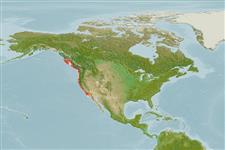>
Ovalentaria/misc (Various families in series Ovalentaria) >
Embiotocidae (Surfperches)
Etymology: Hyperprosopon: Greek, hyper = over + Greek, prosopon = face, snout of animal (Ref. 45335); ellipticum: From the Latin 'ellipticum' - referring to the outline of the body (Ref. 6885).
Environment: milieu / climate zone / depth range / distribution range
Ökologie
seewasser demersal; tiefenbereich 0 - 110 m (Ref. 2850). Subtropical; 56°N - 30°N, 135°W - 116°W
Eastern Pacific: southern British Columbia, Canada to Rio San Vincente, northern Baja California, Mexico.
Size / Gewicht / Alter
Maturity: Lm ? range ? - ? cm
Max length : 27.0 cm TL Männchen/unbestimmt; (Ref. 2850); max. veröff. Alter: 7 Jahre (Ref. 56049)
Rückenflossenstacheln (insgesamt) : 8 - 10; Rückenflossenweichstrahlen (insgesamt) : 25 - 28; Afterflossenstacheln: 3; Afterflossenweichstrahlen: 29 - 34. Dark green dorsally, sides and belly silvery; a series of narrow vertical bars of pale golden pink on body wall; pectoral fins colorless (Ref. 6885). British Columbia specimens dark on end of caudal fin and free edge of spinous dorsal (Ref. 6885).
Found inshore, in surf and sandy areas, also occur around rocks and piers (Ref. 2850). Intertidal and to 110 m (Ref. 96339). Viviparous, female carries the developing young (Ref. 205). Frequently caught, but not of much importance as a sport fish due to its small size (Ref. 2850).
Viviparous, female carries the developing young (Ref. 205).
Eschmeyer, W.N., E.S. Herald and H. Hammann, 1983. A field guide to Pacific coast fishes of North America. Boston (MA, USA): Houghton Mifflin Company. xii+336 p. (Ref. 2850)
IUCN Rote Liste Status (Ref. 130435: Version 2024-2)
Bedrohung für Menschen
Harmless
Nutzung durch Menschen
Fischereien: kommerziell; Sportfisch: ja; Aquarium: Öffentliche Aquarien
Tools
Zusatzinformationen
Download XML
Internet Quellen
Estimates based on models
Preferred temperature (Ref.
123201): 8.3 - 12.8, mean 9.8 °C (based on 64 cells).
Phylogenetic diversity index (Ref.
82804): PD
50 = 0.6250 [Uniqueness, from 0.5 = low to 2.0 = high].
Bayesian length-weight: a=0.01905 (0.00827 - 0.04391), b=2.97 (2.77 - 3.17), in cm total length, based on LWR estimates for this (Sub)family-body shape (Ref.
93245).
Trophic level (Ref.
69278): 3.3 ±0.5 se; based on size and trophs of closest relatives
Widerstandsfähigkeit (Ref.
120179): mittel, Verdopplung der Population dauert 1,4 - 4,4 Jahre. (tm=3; tmax=7).
Fishing Vulnerability (Ref.
59153): Low vulnerability (17 of 100).
